YAMAHA KODIAK 450 2020 Workshop Manual
Manufacturer: YAMAHA, Model Year: 2020, Model line: KODIAK 450, Model: YAMAHA KODIAK 450 2020Pages: 174, PDF Size: 7.44 MB
Page 51 of 174
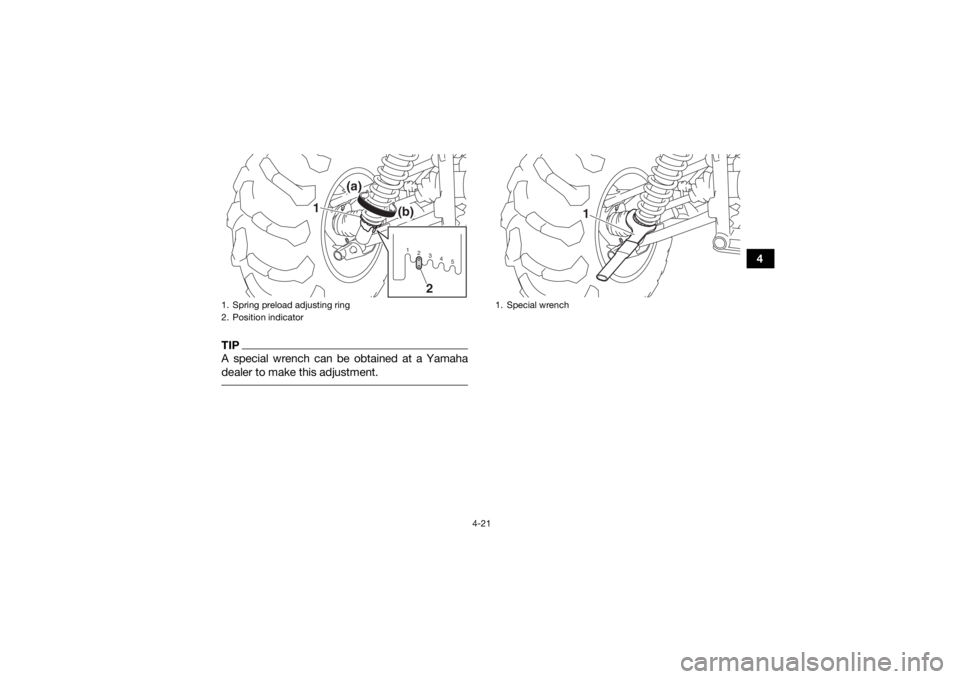
4-21
4
TIPA special wrench can be obtained at a Yamaha
dealer to make this adjustment. 1. Spring preload adjusting ring
2. Position indicator
12345
(a)
(b)
1
2
1. Special wrench
1
UBB562E0.book Page 21 Thursday, March 14, 2019 9:59 AM
Page 52 of 174
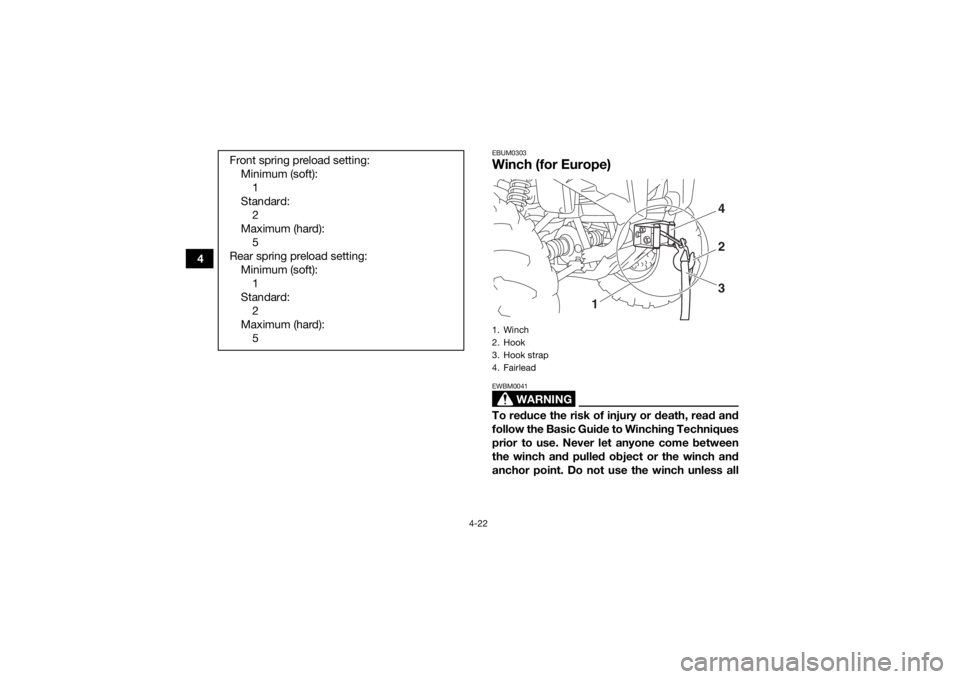
4-22
4
EBUM0303Winch (for Europe)
WARNING
EWBM0041To reduce the risk of injury or death, read and
follow the Basic Guide to Winching Techniques
prior to use. Never let anyone come between
the winch and pulled object or the winch and
anchor point. Do not use the winch unless all
Front spring preload setting:
Minimum (soft):1
Standard: 2
Maximum (hard): 5
Rear spring preload setting: Minimum (soft):1
Standard: 2
Maximum (hard): 51. Winch
2. Hook
3. Hook strap
4. Fairlead
4
2
3
1
UBB562E0.book Page 22 Thursday, March 14, 2019 9:59 AM
Page 53 of 174
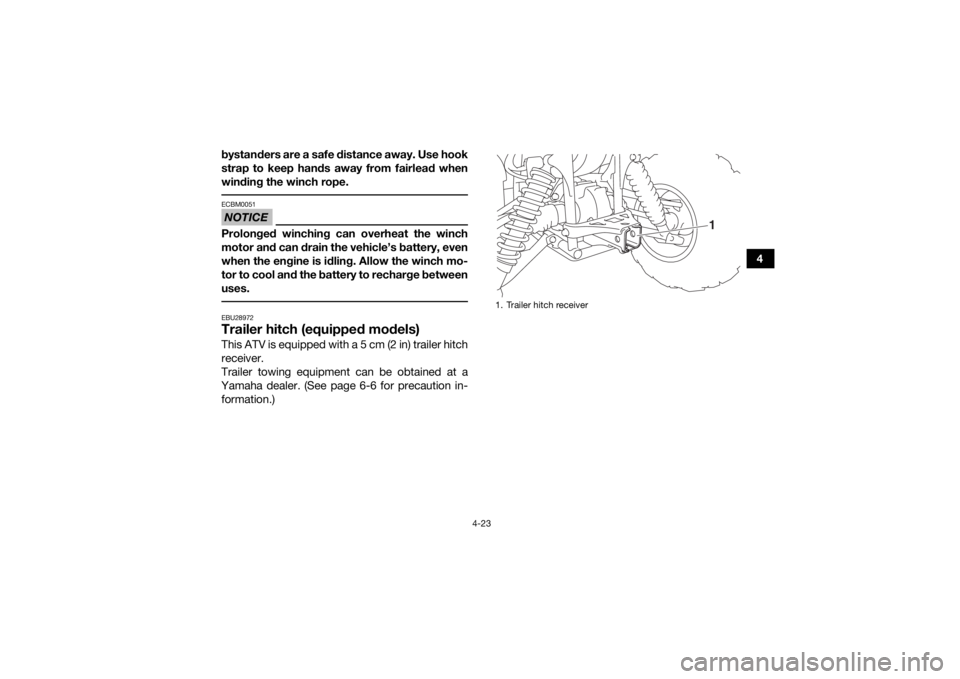
4-23
4
bystanders are a safe distance away. Use hook
strap to keep hands away from fairlead when
winding the winch rope.
NOTICEECBM0051Prolonged winching can overheat the winch
motor and can drain the vehicle’s battery, even
when the engine is idling. Allow the winch mo-
tor to cool and the battery to recharge between
uses. EBU28972Trailer hitch (equipped models)This ATV is equipped with a 5 cm (2 in) trailer hitch
receiver.
Trailer towing equipment can be obtained at a
Yamaha dealer. (See page 6-6 for precaution in- formation.)
1. Trailer hitch receiver
1
UBB562E0.book Page 23 Thursday, March 14, 2019 9:59 AM
Page 54 of 174

4-24
4
EBU19186Auxiliary DC jack
NOTICEECB03760Do not use any single electrical accessory or
combination of accessories that require more
than the stated capacity at any one time. This
may overload the circuit and cause the fuse to
blow. TIPWhen using a winch or other electrical accesso-
ries, the power taken from the DC jack must be re-
duced accordingly. A 12-V accessory, such as a work light or radio
with the proper adapter, can be used when the
main switch is turned on. However, to prevent bat-
tery drain, use when the engine is running and the
headlights are turned off.1. Start the engine.
2. Turn the headlights off.
3. Turn the accessory off.
4. Open the auxiliary DC jack cap.
5. Insert the accessory power plug into the jack.
6. Turn the accessory on.
1. Auxiliary DC jack cap
2. Auxiliary DC jackAuxiliary DC jack system capacity: 10.0 A (120 W)
8.0 A (96 W) (Winch equipped models)
1
2
UBB562E0.book Page 24 Thursday, March 14, 2019 9:59 AM
Page 55 of 174
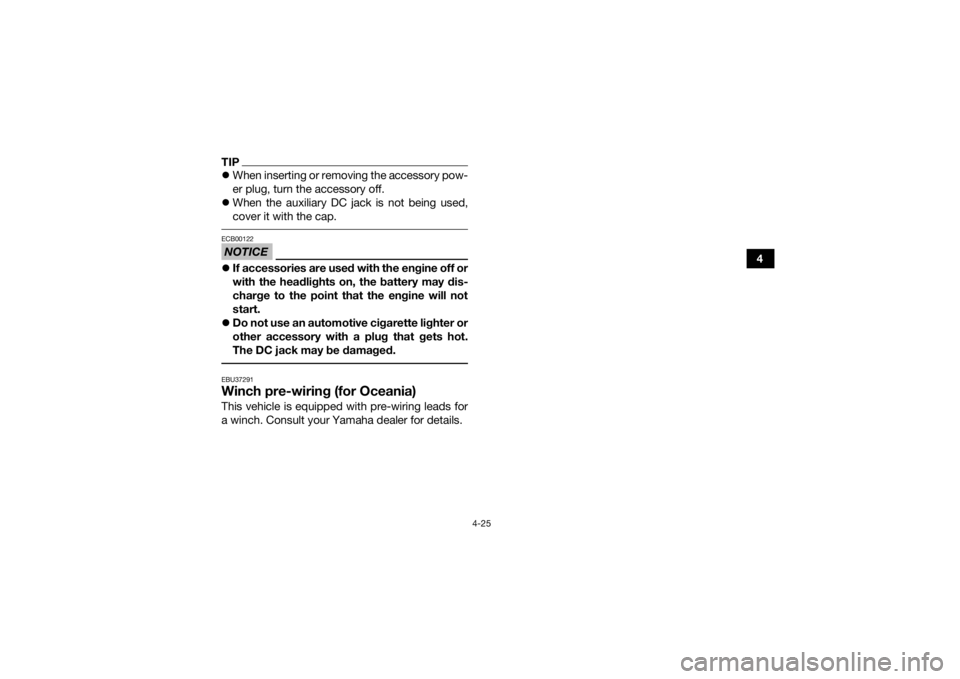
4-25
4
TIPWhen inserting or removing the accessory pow-
er plug, turn the accessory off.
When the auxiliary DC jack is not being used,
cover it with the cap. NOTICEECB00122If accessories are used with the engine off or
with the headlights on, the battery may dis-
charge to the point that the engine will not
start.
Do not use an automotive cigarette lighter or
other accessory with a plug that gets hot.
The DC jack may be damaged. EBU37291Winch pre-wiring (for Oceania)This vehicle is equipped with pre-wiring leads for
a winch. Consult your Yamaha dealer for details.UBB562E0.book Page 25 Thursday, March 14, 2019 9:59 AM
Page 56 of 174
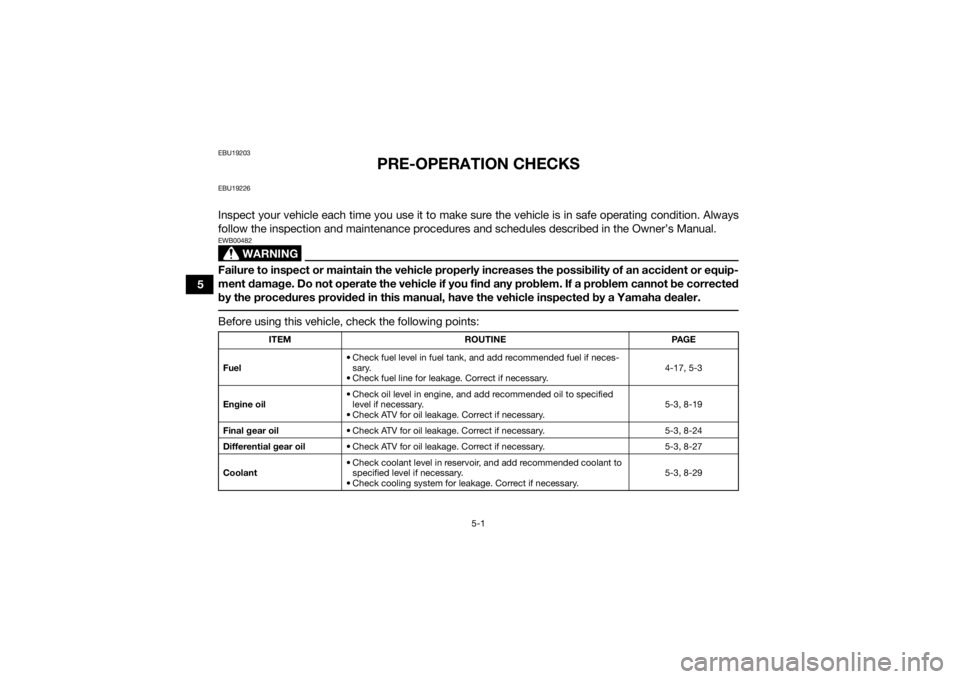
5-1
5
EBU19203
PRE-OPERATION CHECKS
EBU19226Inspect your vehicle each time you use it to make sure the vehicle is in safe operating condition. Always
follow the inspection and maintenance procedures and schedules described in the Owner’s Manual.
WARNING
EWB00482Failure to inspect or maintain the vehicle properly increases the possibility of an accident or equip-
ment damage. Do not operate the vehicle if you find any problem. If a problem cannot be corrected
by the procedures provided in this manual, have the vehicle inspected by a Yamaha dealer. Before using this vehicle, check the following points:
ITEMROUTINE PAGE
Fuel • Check fuel level in fuel tank,
and add recommended fuel if neces-
sary.
• Check fuel line for leakage. Correct if necessary. 4-17, 5-3
Engine oil • Check oil level in engine, and add recommended oil to specified
level if necessary.
• Check ATV for oil leakage. Correct if necessary. 5-3, 8-19
Final gear oil • Check ATV for oil leakage. Correct if necessary. 5-3, 8-24
Differential gear oil • Check ATV for oil leakage. Correct if necessary. 5-3, 8-27
Coolant • Check coolant level in reservoir, and add recommended coolant to
specified level if necessary.
• Check cooling system for leakage. Correct if necessary. 5-3, 8-29
UBB562E0.book Page 1 Thursday, March 14, 2019 9:59 AM
Page 57 of 174

5-2
5
Front brake• Check operation. If soft or spongy, have Yamaha dealer bleed hy-
draulic system.
• Check brake pads for wear, and replace if necessary.
• Check brake fluid level in reservoir, and add specified brake fluid to specified level if necessary.
• Check hydraulic system for leakage. Correct if necessary. 5-3, 8-40, 8-40, 8-42
Rear brake • Check operation, and correct if necessary.
• Lubricate cables if necessary.
• Check lever and pedal free play, and adjust if necessary. 5-3, 8-40, 8-42
Throttle lever • Make sure that operation is smooth. Lubricate cable and lever
housing if necessary.
• Check lever free play, and adjust if necessary. 5-4, 8-38
Control cables • Make sure that operation is smooth. Lubricate if necessary. 8-49
Wheels and tires • Check wheel condition, and replace if damaged.
• Check tire condition and tread depth. Replace if necessary.
• Check air pressure. Correct if necessary. 5-4
Brake pedal • Make sure that operation is smooth. Lubricate pedal pivoting point
if necessary. 8-50
Brake levers • Make sure that operation is smooth. Lubricate lever pivoting points
if necessary. 8-49
Axle boots • Check for cracks or damage, and replace if necessary. 8-47
Chassis fasteners • Make sure that all nuts, bolts and screws are properly tightened. 5-7
Instruments, lights and
switches • Check operation, and correct if necessary. 5-7
ITEM ROUTINE PAGE
UBB562E0.book Page 2 Thursday, March 14, 2019 9:59 AM
Page 58 of 174

5-3
5
EBU38000FuelMake sure there is sufficient gasoline in the tank
before starting off. Refuel if necessary. (See page
4-17.)EBU19561Engine oilMake sure that the engine oil is at the specified
level. Add oil as necessary. (See page 8-19.)EBU19591Final gear oilMake sure that the final gear oil is at the specified
level. Add oil as necessary. (See page 8-24.)EBU19601Differential gear oilMake sure that the differential gear oil is at the
specified level. Add oil as necessary. (See page
8-27.)EBU19632CoolantMake sure that the coolant is at the specified level.
Add coolant as necessary. (See page 8-29.)
TIPThe coolant level must be checked on a cold en-
gine since the level varies with engine tempera-
ture. EBU28533Front and rear brakesBrake levers and brake pedal
Check that there is no free play in the front
brake lever. If there is free play, have a Yamaha
dealer check the brake system.
Check for correct free play in the rear brake le-
ver and brake pedal. If the free play is incorrect,
adjust it. (See page 8-42.)
Check operation of the levers and pedal. They
should move smoothly and there should be a
firm feeling when the brake is applied. If not,
have a Yamaha dealer check them.
Brake fluid level (front brake)
Check the brake fluid level. Add fluid if necessary.
(See page 8-40.)
Specified brake fluid:DOT 4
UBB562E0.book Page 3 Thursday, March 14, 2019 9:59 AM
Page 59 of 174
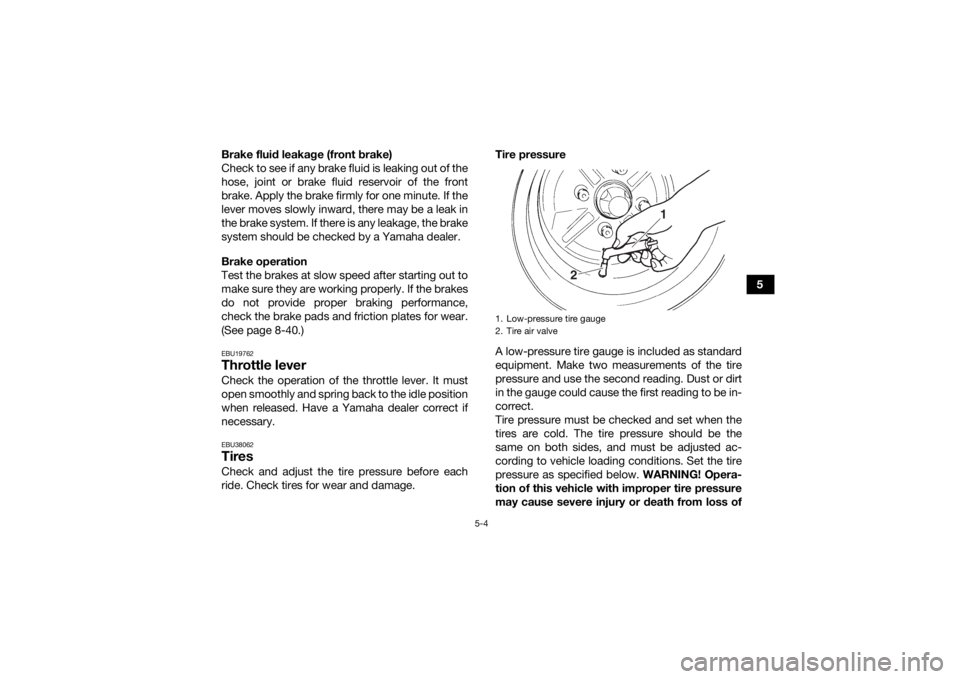
5-4
5
Brake fluid leakage (front brake)
Check to see if any brake fluid is leaking out of the
hose, joint or brake fluid reservoir of the front
brake. Apply the brake firmly for one minute. If the
lever moves slowly inward, there may be a leak in
the brake system. If there is any leakage, the brake
system should be checked by a Yamaha dealer.
Brake operation
Test the brakes at slow speed after starting out to
make sure they are working properly. If the brakes
do not provide proper braking performance,
check the brake pads and friction plates for wear.
(See page 8-40.)
EBU19762Throttle leverCheck the operation of the throttle lever. It must
open smoothly and spring back to the idle position
when released. Have a Yamaha dealer correct if
necessary.EBU38062TiresCheck and adjust the tire pressure before each
ride. Check tires for wear and damage. Tire pressure
A low-pressure tire gauge is included as standard
equipment. Make two measurements of the tire
pressure and use the second reading. Dust or dirt
in the gauge could cause the first reading to be in-
correct.
Tire pressure must be checked and set when the
tires are cold. The tire pressure should be the
same on both sides, and must be adjusted ac-
cording to vehicle loading conditions. Set the tire
pressure as specified below.
WARNING! Opera-
tion of this vehicle with improper tire pressure
may cause severe injury or death from loss of
1. Low-pressure tire gauge
2. Tire air valve
1
2
UBB562E0.book Page 4 Thursday, March 14, 2019 9:59 AM
Page 60 of 174
![YAMAHA KODIAK 450 2020 Workshop Manual 5-5
5control or rollover. Tire pressure below the
minimum specified could also cause the tire to
dislodge from the rim under severe driving
conditions.
[EWB04120]
OPERATING TIRE PRESSURE (cold):
For YAMAHA KODIAK 450 2020 Workshop Manual 5-5
5control or rollover. Tire pressure below the
minimum specified could also cause the tire to
dislodge from the rim under severe driving
conditions.
[EWB04120]
OPERATING TIRE PRESSURE (cold):
For](/img/51/50538/w960_50538-59.png)
5-5
5control or rollover. Tire pressure below the
minimum specified could also cause the tire to
dislodge from the rim under severe driving
conditions.
[EWB04120]
OPERATING TIRE PRESSURE (cold):
For Oceania
Front: (Recommended)35.0 kPa (0.350 kgf/cm², 5.0 psi)
Rear: (Recommended) 30.0 kPa (0.300 kgf/cm², 4.4 psi)
Front: (Minimum) 32.0 kPa (0.320 kgf/cm², 4.6 psi)
Rear: (Minimum) 27.0 kPa (0.270 kgf/cm², 4.0 psi)
For Europe No cargo or trailer: Front: (Recommended)35.0 kPa (0.350 kgf/cm², 5.0 psi)
Rear: (Recommended) 30.0 kPa (0.300 kgf/cm², 4.4 psi)
Front: (Minimum) 32.0 kPa (0.320 kgf/cm², 4.6 psi)
Rear: (Minimum) 27.0 kPa (0.270 kgf/cm², 4.0 psi)
With cargo or trailer: Front: (Recommended)50.0 kPa (0.500 kgf/cm², 7.3 psi)
Rear: (Recommended) 50.0 kPa (0.500 kgf/cm², 7.3 psi)
Front: (Minimum) 45.0 kPa (0.450 kgf/cm², 6.5 psi)
Rear: (Minimum) 45.0 kPa (0.450 kgf/cm², 6.5 psi)
Maximum load: Veh i cl e:240.0 kg (530 lb)
The vehicle’s maximum load is the com-
bined weight of the rider, accessories, car-
go, and trailer tongue weight.
UBB562E0.book Page 5 Thursday, March 14, 2019 9:59 AM